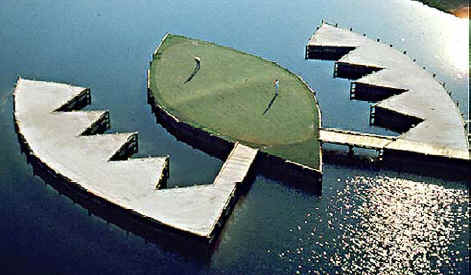I am still recovering from shoulder surgery which has delayed the opening of my golf season for a few weeks. So when I had the opportunity to do something golf related that didn’t involve me taking a divot I took it.
This past Saturday I headed down to the campus of the USGA in Far Hills, N.J. for their first Golf Course Architecture Symposium.
Now, normally anything with symposium in the title usually has me heading in the other direction but course architecture has been one of my interests lately and after a look at the four guest speakers I couldn’t pass up the opportunity to hear them.
First up was Dr. Michael Hurdzan who has more degrees than a drawer full of thermometers. The good doctor is a recognized authority on golf course environmental issues and a prolific architect. (He even designed my brother’s course, Sterling CC, in Sterling MA.)
It appeared the theme of the morning session was the U.S. Open as Hurdzan is the designer of Erin Hills, site of the ‘17 U.S. Open. He discussed the design and construction of Erin Hills and sustainability, which is the new hot button for golf course developers.
Hurdzan broadened the meaning of sustainability to include the economics of the course not just the environmental aspects and it is easy to see the depth of his knowledge in all phases of what goes into a golf course.
Next up was Robert Trent Jones II who just so happens to have designed the site of this year’s U.S. Open, Chambers Bay. Bobby, as I overheard his fellow architects call him can certainly tell a story.
Bobby filled us in on how Chambers Bay was dug out of an old mining complex and how they moved over 1,500,000 cubic yards of sand to get the humps, bumps and hillocks that make Chambers Bay a links style course.
In fact, since it sits hard against Puget Sound and is all sand based he insists this is an authentic links course.
The players at this year’s Open are in for a treat. They’ll think the Open Championship has taken over their U.S. Open when they start to play their practice rounds. He went so far as to say it “feels like Liverpool. This is Liverpool.”
One of the design aspects of Chambers Bay is these “ribbon tees” that twist and turn and can be one hundred yards long giving Mike Davis and his setup team a vast array of options.
Jones called Davis a genius and worked closely with Davis on changes the USGA needed for the Open. One change was a bunker, a deep bunker, twelve feet deep on the eighteenth. If played as a par five which it is listed as now the bunker will not be in play for the pros.
But if the genius that is Davis decides to move the tees up on that one hundred yard ribbon tee that Jones created the bunker is now in play. Jones hinted that the hole could be played as a par five or be switched to a par four.
Don’t be surprised if we have architecture history in June when Davis plays the eighteenth as a par five one day and a par four the next.
The afternoon session had Dr. Rand Jerris of the USGA discuss Golf Course Architecture as Art and Architect Forrest Richardson relate stories about his years spent with Desmond Muirhead.
Muirhead, in Jerris’ words was one of the most misunderstood and maligned course designers but is now appreciated for his forward thinking that was so controversial at the time.
Richardson, a renowned and prolific architect with the majority of his courses in the western United States knew Muirhead personally from the time he showed up on his doorstep as a thirteen year old publisher of a golf newsletter called “Golf Course Designer.”
Muirhead was stuck by the teenage Richardson’s passion for architecture and fronted him the money to continue to publish his newsletter, $75 back then in 1972.
Forrester broke Muirhead’s life into four parts. The first was his life in the Royal Air Force where he was a navigator. Secondly, he spent about ten years in Hawaii surfing and writing and chilling out.
The third phase was a very successful course design phase when he worked with Jack Nicklaus on his cherished Muirfield Village. Muirhead invented the Planned Golf Community and used the golf course as its landscape and curb appeal.
The final stage was a period where Muirhead designed some of the most outlandish holes and courses which featured floating greens and even floating bunkers.
The final headliner of the day was Gil Hanse, one of the hottest architects on the planet and the designer of the 2016 Olympic Course in Rio.
Now, Hanse let us know that he had signed plenty of confidentiality agreements so he couldn’t give us all the inside dope on Rio but he still painted a pretty clear picture of how things went down there.
First thing he tells us that on the night before he is supposed to leave for Brazil he can’t find his passport. So these guys have the same problems we do, that’s nice. Anyway, after a cancelled flight, a super-expedited passport the next day and a quick visa from a golf loving diplomat at the Brazilin Embassy he was on his way.
He gets there an hour and a half before they are scheduled to present: he said it was a blessing because he didn’t have time to worry or rethink the presentation.
They nailed the presentation and he thought the fact that he said he was moving his family including his sixteen year old daughter to Rio during the build may have won it for him.
He wasn’t feeling that way later after things “went sideways” and one stumbling block after another stopped the course dead.
After seven months he sent his wife and daughter home and dealt with the hassles himself.
As far as the course itself, with all the construction finally done and all the holes in “grow in” mode he thinks all will be well for the Olympics.
It’s a course reminiscent of the Australian Sandbelt courses with scrubby areas framing hard, fast sand based fairways.
With all the aggravation and controversy he still said he would do another Olympic course again. Hey, it was Rio so it couldn’t have been all bad.
For a golf geek like me the day at the USGA listening to these guys who have shaped and continue to shape the physical golf world was a rare treat indeed.




